 meander - To follow a winding and turning, seemingly random
or chaotic course.
Curvatious windings or sinuosities,
as of
meander - To follow a winding and turning, seemingly random
or chaotic course.
Curvatious windings or sinuosities,
as of a stream
or path. May refer, in Greek
art and architecture, to
a fret or key
pattern.
Meanders are among the ten classes of patterns.
(pr. mee-AN-dər)
Example of meander in art:

Brice Marden (American, 1938-), Couplet
III, 1988-9, oil on
canvas, 274.0 x 152.0 cm,
Tate Gallery, London. In the 1980s, Marden developed a fluid
and expressive style
that he said was influenced by nature,
Eastern mysticism, and calligraphy.
In such paintings as Couplet III Marden produced webs
of meandering lines that resemble roots and branches.
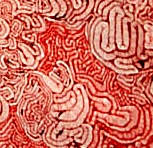
Tim Hawkinson (American, 1960-), two works: back: Graph, 1999, red ink on chrome-coated paper on wooden panel, 96 x 144 inches; right and detail: Wall Chart of World History from Earliest Times to the Present, 1997, pen and pencil on paper, 51 x 396 inches, ACE Gallery, Soho, NY, NY. A detail of Wall Chart exhibits the sort of meandering design Wilkinson drew all over this work — "what appears to be an obsessivly elaborate improvisational drawing of intestines, Pre-Columbian motifs, a labyrinth of inner and outer space," said a critic on artseensoho.com. See diagram, graph, obsession, Pre-Columbian art, and space.
Also see form, labyrinth, line, serpentine, shape, snake, and straight.
meaning - What is conveyed or signified by something; its sense or significance. An interpretation. However an artist may intend an artwork to impart meaning, and whatever an artist does to pack a work with meaning, in the end, it is the viewer who creates meaning in each and every image.
Quotations:
Also see absurd, aesthetics, ambiguous, amphibolous, art criticism, attitude, coherence, communication, concept, creativity, cryptic, definition, déjà vu, description, empiricism, epistemology, expression, fantasy, gestalt, graphic design, iconology, irony, knowledge, memory, mind, mystery, nuance, quotations, semiotics, text, and theater.
measure and measurement - See angstrom, Centigrade, centiliter, centimeter, circumference, cubic, diameter, dimension, direction, foot, gauge, gram, hardness, horology, iconometer, inch, kilogram, liter, meter, metric system, mil, milliliter, millimeter, paper, pi, pica, polygon, polyhedron, pound, quart, ream, scale, size, temperature, time, volume, weight, yard, and the names of the kinds of materials to be measured, such as color, light, nails, paper, sand, sheet metal, and wire. (pr. MEH-zhər)
Related links:
Also see assessment, ASTM International (American Society for Testing and Materials), effort, interdisciplinary, music, protractor, rhythm, mathematics and art, science and art, sequence, and straight.
mechanical drawing - Drawing of mechanical subjects, done by a draftsman with the help of mechanical tools or instruments, such as a compass and a T-square. More of this kind of drawing is being done with the use of computers than in the past, and is then referred to as computer graphics or computer assisted design (CAD). This is the opposite of freehand drawing.
Examples:

 Here is a
Here is a photo of a manufactured machine part, and
two
mechanical drawings of it, each a different point
of view.
Also see applied arts, commercial art, cross-section, draftsmanship, fabricate, French curve, line, linear, perspective, plan, and scale.
mechanical scale - The size or proportion (scale) of something relative to an accepted standard of measurement, as when the dimensions of a doorway or a staircase are other than those established to relate to human scale.
Also see architecture, iconometer, and visual scale.
medal - A flat piece of metal that is embossed or engraved with a design, and intended to honor or remember a person or event. Medals are usually coin-shaped. The front or primary side is known as the obverse, and the back or secondary side as the reverse.
Examples:

French, Bust of Louis XIV (1644-1712), silver medal, Bibliotheque Nationale
de France, Paris. See Baroque,
engraving,
and portrait.
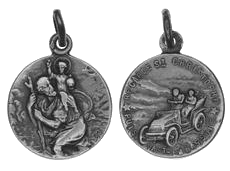
France, St. Christopher Medal, early 20th century,
British Museum, London. According to legend, St. Christopher
was a strong man who served Christ by carrying travelers across
a river, and on one occasion carried a small child who eventually
revealed his identity. Wearing such a medal as this, many have
believed, will protect them when travelling, making it also an
amulet. On the medal's obverse is a traditional
representation of the saint
carrying Christ. On the reverse
is an early automobile, along with an inscription
meaning, "Look at St. Christopher and travel strengthened."
The Roman Catholic Church officially withdrew sainthood from
St. Christopher in 1969.


Paul Manship (American, 1886-1966), John
F. Kennedy Inaugural Medal (obverse and reverse
), 1961, bronze,
National Museum of American Art, Washington, D.C.
Also see American Watercolor Society (AWS), exonumia, and memorial.
medallion - A large medal worn around the neck on a heavy chain, ribbon, or rope. Or, a relief sculpture resembling a medal, usually of circular or oval design, used as a decoration.
Examples:
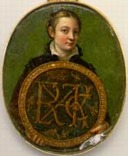
Sofonisba Anguissola (Italian, c. 1535-1625),
Self-Portrait, c. 1555, oil
on parchment, 3 1/4 x 2 1/2
inches (8.2 x 6.3 cm), Museum of Fine Arts, Boston. The artist holds a medallion inscribed
in Latin around the rim: "The maiden Sofonisba Anguissola,
depicted by her own hand, from a mirror, at Cremona." Inside
the circle is a cryptogram
whose entwined letters are
included in the name of Anguissola's father, Amilcare. The meaning and original purpose of this
enigmatic portrait remain a mystery.
See Baroque,
circle, cryptic,
feminism and feminist art, miniature, mirror,
oval, and self-portrait.

Guillaume Dupre (French, c. 1576 - 1643), Marie de Medicis, Queen of France, 1624, bronze, Hood Museum of Art, Dartmouth College, NH.
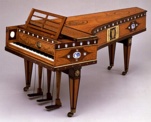
John Broadwood and Son, piano designer (English,
active 1795-1808), with cameos and medallions designed by Josiah
Wedgwood (1730-1795), case decoration by Thomas Sheraton (1751-1806),
Grand Piano, 1796, veneered
case of satinwood, tulipwood, and purpleheart with Wedgwood cameos and medallions;
piano: 97 7/8 x 43 7/8 x 35 7/8 inches (248.7 x 111.5 x 91.2
cm), detail of lilac Wedgwood medallion: c. 3 inches across (7.6
cm), Museum of Fine Arts, Boston. See wood.
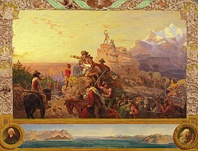
Emanuel Gottlieb Leutze (German-American, 1816-1869), Westward the Course of Empire Takes Its Way, 1861, oil on canvas, 33 1/4 x 43 3/8 inches, Smithsonian American Art Museum, Washington, DC. The painting's title, taken from a poem written in 1726 by Irish poet George Berkeley, became a motto for America's quest for Manifest Destiny — the 19th century drive to grow the nation over vast frontiers. Here a group of pioneers have just passed Native Americans to achieve the summit of a climactic, mountainous barrier. Leutze placed a panoramic view of their ultimate goal, San Francisco Bay, at the bottom of the composition, flanked by medallion portraits of William Lewis and Daniel Boone. This easel painting is a study for a mural in the United States Capitol. See history painting.
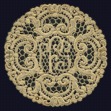
French?, Lace Medallion, late 19th century, "point
de France" style needlepoint,
monogrammed "FGP",
diameter 61/2 inches (16.5
cm), Marla
Mallett collection, Atlanta, GA. See textile and medallion.
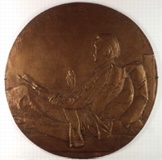
Augustus Saint-Gaudens (American, born Ireland, 1848-1907), Robert Louis Stevenson, originally modeled 1887-88, reworked in reduction and cast 1895-1926, bronze, 17 9/16 x 17 3/17 inches (44.6 x 43.7 cm), North Carolina Art Museum, Raleigh. Saint-Gaudens reported, "I began the medallion at his rooms in the Hotel Astor [in New York City]."
Also see pendant, plaque, and radial.
media - The plural form of medium. Also, may refer to mass media, which includes such printed media as books, magazines, and newspapers; radio; cinema; and such electronic media as television, Web pages, CD-ROMs, DVDs, etc. The term new media has become widely used from the early 1990s to refer to the latest electronic media, as well as what effects are now possible with recently developed hardware devices and software.
Also see feather, hypermedia, and mixed media.
medieval - Refers to the Middle Ages.
mediocre - Ordinary; average to inferior in quality, with a negative connotation.
Quotes:
Also see bad art, derivative, miserable failure, and ugly.
medium - The material or technique used by an artist to produce a work of art.
Medium can also refer to what carries a paint's pigments, and is also called a vehicle or a base. The medium is what determines what kind of paint is produced. A painter can mix a medium with its solvents, pigments and other substances in order to make paint and control its consistency. A variety of mediums are available that provide a matte, semi-gloss, or glossy finish.
| medium | paint |
|---|---|
| linseed oil | oil paint |
| gum arabic | watercolor |
| gum arabic | gouache |
| casein (milk-glue) | casein |
| egg-yolk | egg tempera |
| gum triganth | student tempera |
| beeswax or other waxes | encaustic |
| fresco | plaster |
The plural form can be either media or mediums.
Be careful not to confuse "medium" with " solvent." Thanks to Julie Shaw at BCC in Chico!
Also see binder, clay, conté crayon, feather, filler, glass, ink, mass media, metal, mixed media, new media, oil, ox gall, paper, polymer clay, stone, support, synthetic, tradigital, and wetting agent.
megalith - Literally, "great stone"; a large, roughly hewn stone used in the construction of monumental, Stone Age structures such as dolmen. The adjectival form is megalithic.
Related resource:
Also see colossus and colossal, cromlech, menhir, monolith, and obelisk.
megalography - A genre in which representations are intended to glorify or idealize excessively some event, person or thing.
megaron - A rectangular hall, fronted by an open, two-columned porch, traditional in Greece since Mycenaean times.
Also see Greek art.
megilp - A mixture of linseed oil and mastic (or turpentine) used as a medium.
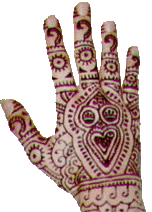 mehndi -
The traditional art of hand and foot painting
in India, and parts of Africa and the Middle East, especially
for weddings, festivals, and other celebrations. (Literally, mehndi
is an Indian word meaning myrtle, a plant important to many Indian
people, especially those of Rajasthan.) Among the most common
motifs in the design
of mehndi in India are: kairi (meaning mango) or paisley
— portraying a slice of the fruit, rupee (the currency of India),
peacock (the national bird of India), singhada (water chestnut),
rice, lotus creeper, mehndi (myrtle) plant, sakarpara (a sweet
Indian pastry), chopra (a board game), kumbh kalash (sacred urn),
tulsi plants, bajot (ceremonial table for serving special meals),
and bijani (fan).
mehndi -
The traditional art of hand and foot painting
in India, and parts of Africa and the Middle East, especially
for weddings, festivals, and other celebrations. (Literally, mehndi
is an Indian word meaning myrtle, a plant important to many Indian
people, especially those of Rajasthan.) Among the most common
motifs in the design
of mehndi in India are: kairi (meaning mango) or paisley
— portraying a slice of the fruit, rupee (the currency of India),
peacock (the national bird of India), singhada (water chestnut),
rice, lotus creeper, mehndi (myrtle) plant, sakarpara (a sweet
Indian pastry), chopra (a board game), kumbh kalash (sacred urn),
tulsi plants, bajot (ceremonial table for serving special meals),
and bijani (fan).
Also see body art, Hindu art, and tattoo.
melamine - A synthetic resin or material manufactured from that resin. Melamine can be purchased in tough, non-porous sheets.
melting point - The temperature at which a solid substance becomes liquid.
Some melting points of particular importance:
![]() The boiling point of a substance is always
appreciably higher than its melting point. The boiling point is
the temperature at which a material
changes from a liquid to a gas. Below the boiling point, the liquid
can evaporate to form a vapor. As the material approaches the
boiling point, the change from liquid to vapor is rapid, and vapor
concentrations in the air can be
The boiling point of a substance is always
appreciably higher than its melting point. The boiling point is
the temperature at which a material
changes from a liquid to a gas. Below the boiling point, the liquid
can evaporate to form a vapor. As the material approaches the
boiling point, the change from liquid to vapor is rapid, and vapor
concentrations in the air can be extremely
high. Airborne gases and vapors may pose fire, explosion and health
hazards. Sometimes the boiling point of a mixture is given as
a range of temperatures. This is because the different ingredients
in a mixture can boil at different temperatures.
Also see alloy, flammable, freezing point, hygrothermograph, lost-wax casting, measurement, metal, pyrometric cones (firing ceramics), and temperature conversions between Fahrenheit and Centigrade.
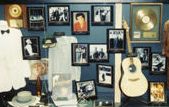
memorabilia - Objects
collected for their historical
significance, for the memories they evoke — often sentimental.
Examples include old posters
and other advertisements, election
campaign buttons, party invitations, packaging,
theater tickets, and other realia
and ephemera.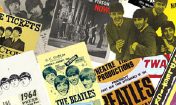 Memorabilia associated with the people and events history remembers is more
collectible than objects associated with people and events history forgets.
Memorabilia associated with the people and events history remembers is more
collectible than objects associated with people and events history forgets.
Souvenirs qualify as memorabilia, but souvenirs are more likely to remind a collector of specific places or events.
(pr. MEH-mah-rə-BEE-lee-ə)
Also see bric-a-brac, found objects, historicity, kitsch, low art, mass media, polypropylene, popular culture, relic, and reliquary.
menhir - A Stone Age monolith, uncut or roughly cut, standing singly or with others in rows or circles.
Examples:

Dame Barbara Hepworth (English, 1903-1975),
Two Figures (Menhirs), 1964, slate,
82.5 x 63.8 x 32.0 cm, Tate Gallery, London. Not really
examples; this modern sculpture takes
the form of stylized
menhirs. See English art, feminism
and feminist art, and negative
space.
mercury gilding - See fire gilding.
Meroitic art - Contemporary with early imperial Rome, the Meroitic civilization flourished along the fertile banks of the Nile River in the land of Kush in what is now the Sudan. This African dynasty traded not only with Egypt to the north but also with Greece, Rome, and peoples of the Near East. Consequently, official Meroitic art reflects the absorption of external influences adapted to serve local rulers.
An example:
![]()

Meroitic, Prince Arikankharer Slaying His Enemies,
CE
25-41, sandstone, Worcester
Art Museum, MA.
Also see archaeology.
mesh - The size of the holes in a screen or sieve; also, to strain through a sieve.
mesolithic - See Stone Age.
meta-cognition or metacognition - Thinking about what one is thinking, or, self-monitoring one's cognitive process. Some propose that meta-cognition represents the seventh and highest level of learning outcomes in the cognitive domain — the level of understanding just beyond synthesis and evaluation.
Also see Bloom's Taxonomy and theory.
metal and metallurgy - Metal is a category of elements with supreme capacities for shape-shifting, physical strength, and weight. Metal's surfaces can show an array of colors and textures, capable of polishing to a high gloss. They can be melted, cast, or fused, hammered into thin sheets, or drawn into wire. Typical metals form basic oxides with oxygen, salts with nonmetals, and alloy with each other. Examples include aluminum, antimony, chrome, copper, gold, iron, lead, nichrome, nickel, palladium, platinum, silver, tin, titanium, and zinc.
Metallurgy is the science that deals with procedures used in the extracting metals from their ores, purifying and alloying metals, and creating useful objects from metals. Further information about many such topics can be found in articles about specific metals, techniques, processes, and art forms.
The development of means to form metal objects is among the historical landmarks in human history. In most parts of the world its early uses followed those of stone, ceramics, and textiles. Since ceramics and metallurgy involved fire and an alchemical transformation that must have struck early humans as fantastic, they figured importantly in creation narratives. Artists in primitive cultures often doubled as shamans and priests, but smiths were even more apt to do so. The meshing of religion, economic might, social and political status with daily usefulness is especially potent in metals because of their inherent beauty and durability. In its rawest state, metal has always had high market value and quickly became the most common form of currency. The durability that made it so structurally powerful helped many metal objects survive where ceramics shattered and fibers rotted. But great worth also eradicates objects and therefore history: metal things were, and still are, continuously melted down to make other metal things.
![]()
 Safety concerns with metals:
Safety concerns with metals:

Also see anneal, arsenic, brass, britannia, bronze, ductile, electroplate, electrum, foil, Index of American Design, interdisciplinary, kerf, leaf, melting point, memory, metallic lamelia, metalpoint, mirror, Mohs Scale of Hardness, nonferrous, openwork, patina, pewter, science and art, solder, staple, temperature, welding, and the names of things made of metal, such as architecture, chisels, fettling knives, nails, needle files, pen nibs, and sculpture.
metallic lamelia - Foil adhered to paper.
metalpoint - A metal stylus of lead, bismuth, silver, or gold, which, when drawn upon an abrasive surface, produces a faint gray line — a trail of extremely fine particles of metal rubbed from the stylus. Metalpoint lines become more visible as those particles oxidize. Artists of the fifteenth and sixteenth centuries drew with metalpoint on papers coated with bone-dust or chalk (usually tinted). "Metalpoint" is the most common name for such styluses, even though they may be of any of several different metals, because it is difficult to identify the specific metal a draftsman used by simple observation. Contemporary scientific methods can reliably identify the metal in such work. Alphonse Legros (French, 1837-1911) was one of the several artists who revived the use of metalpoint in the late nineteenth and early twentieth centuries.
Related link:
Also see burin, graffito, and stylus.
metallurgy - See metal and metallurgy.
métamatic and métaméchanique - In the work of Jean Tinguely (Swiss, 1925-), machines programmed electronically to act with antimechanical unpredictability, jerking eratically, sometimes scribbling on rolls of paper. Tinguely was influenced by Klee, Miró and Duchamp. His most famous work was Homage to New York, 1960, an assemblage including an old piano, a pram, a meteorological balloon, and various machine parts; it self-destructed with pyrotechnics before a crowd; its remnants now at the Museum of Modern Art, NY.
Also see automata, Dada and Surrealism.
metamorphic rock - Rock formed from igneous or sedimentary rock which has been geologically changed in its crystalline structure by great heat and pressure. Examples include marble, schist, and slate.
Also see stone.
metamorphosis - A transformation, as by magic. To metamorphose is to change in appearance, character, condition, or function. In biology, a change in the form and perhaps the habits of an animal during its normal life cycle, as, in insects, the transformation of a caterpillar into a butterfly and, in amphibians, the changing of a tadpole into a frog.
Examples:
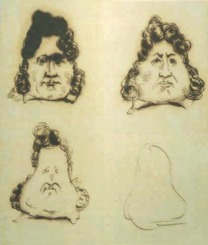
Charles Philipon (French, 1800-1862), La Métamorphose
du roi Louis-Philippe en poire (The Metamorphosis of King Louis-Philippe
into a Pear), c. 1831, pen
and bister-ink drawing, Bibliotheque Nationale de France,
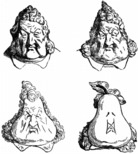 Paris.
Paris.
See these sketches as they were redrawn
for publication in Charivari
in 1834.
The set of four stages of a metamorphosis begins with an accurate portrait of King Louis-Philippe (1830-1848) whose face Philipon gradually transformed into a pear. The pear immediately was taken as a symbol of the soft, overweight king. Louis-Philippe, the so-called "Citizen King" was a favorite target of republican caricaturists, including Honoré Daumier, until censorship was reinstated in September 1835.
Maurits Cornelis Escher (Dutch , 1898-1972), Metamorphosis II. See horizontal, Op Art, optical illusion, and tessellation.
![]() Roy Lichtenstein (American, 1923-1997),
Roy Lichtenstein (American, 1923-1997), the six prints in the "Bull Profile Series,"
the six prints in the "Bull Profile Series,"

![]()


![]()


and Bull
VI, 1973, each is a lino-cut on paper,
and each is 68.5 x 89.0 cm, Tate Gallery, London. From first
to last in this series, Lichtenstein's bulls metamorphose from
figurative to abstract.
See Pop Art.
Metamorphosis is an important technique in film animation. Using computer programs to produce such effects is sometimes called morphing.
Also see anamorphosis, change, gestalt, gradation, interdisciplinary, rhythm, and science and art.
metaphor - A situation in which a word or thing that ordinarily designates one thing is used to designate another, thus making an implicit comparison. One thing conceived as representing another; a symbol. One of the basic tropes, along with simile, metonymy, synecdoche, irony, parody, etc., metaphor is most often confused with simile. But simile is specific, as in Robert Burns' "O my love's like a red, red rose," while metaphor is poetic, as in U.S. Grant's "I am a verb." Grant could have said "I am a man of action, like a verb," which would have been a simile; instead he let the reader take the metaphoric leap. A metaphor is like a fragrance that calls up a powerful memory (which is a simile), while a simile lets a metaphor be its umbrella. (So I strain for effect. A lexicographer's reach must exceed his grasp, or what's a metaphor?)
Quote:
Also see analogy, appropriation, content, genius, incongruity, labyrinth, representation, and simulacrum.
metaphysics - The branch of philosophy concerned with the ultimate nature of existence. Ontology (the study of the nature of being), cosmology, and philosophical theology are its main branches.
Quote:
Also see empiricism, epistemology, fifth dimension, interdisciplinary, phenomenology, and teleology.
meter - A measure of distance, a little longer than a yard. To convert meters into centimeters, multiply them by 100; into feet, x 3.28084; into inches, x 39.3701; into yards, x 1.0936. To convert square meters into square feet, multiply them by 10.7639; into square yards, x 1.19599. To convert cubic meters into cubic feet, multiply them by 35.3147, into cubic yards, x 1.30795. Abbreviated m.
métier - An activity or a subject in which an artist specializes, or for which he is especially suited; his forté.
(pr. MAY-tee-ay)
Also see exemplar, exemplum, and master.
metonymy - A situation in which one word or thing is substituted for another with which it is closely associated. Not to be confused with metaphor or symbol. One of the basic tropes, along with metaphor, synecdoche, irony, parody, etc.
(pr. muh-tah'nuh-mee)
Also see analogy, content, simile, and taxis.
![]()
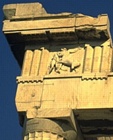
![]() metope
- The space between triglyphs
in a Doric frieze,
part of the entablature which
is above columns. Or a comparable
space on another object.
metope
- The space between triglyphs
in a Doric frieze,
part of the entablature which
is above columns. Or a comparable
space on another object.
(pr. MEH-tə-pee)
Examples:

Greece,
Cycladic, Large pithos, terra
cotta with relief decoration,
c. 675 BCE,
Archaeological Museum of Thera. The metope on the neck of this
vase is decorated with a swan and
the band on the shoulder shows two chariots drawn by winged horses.
It was taken from a child-burial at the cemetery of ancient Thera,
on the north slope of Mt. Sellada. See pithos.
A metope as it figures into a schematic diagram of the Doric order, but not into a diagram of the Ionic order.
Greece, Olympus (Northwest of the Peloponnesus), c. 460 BCE, West Metope from the Temple of Zeus at Olympus: Hercules and the Cretan Bull, Paros marble, height 114 cm, Louvre.
Also see abacus, architrave, classical orders, Greek art, Ionic, and Roman art.
metric system - See centigrade, centimeter, circumference, cubic, diameter, dimension, foot, gauge, gram, horology, inch, kilogram, liter, meter, milliliter, millimeter, paper, pi, pica, polygon, polyhedron, pound, quart, ream, temperature, time, volume, yard, and the names of the kinds of materials to be measured.
Mexican-American art - See Chicano art / Chicana art, Mesoamerican art, and Mexican art.
mezzotint or mezzoprint - In printmaking, an engraving process that is tonal rather than linear, or prints produced by this process. Developed in the seventeenth century, mezzotint was used widely as a reproductive printing process, especially in England, until photographic processes overtook it in the mid-nineteenth century. Mezzotints were most commonly produced from 1780s-1870s. A copper or steel plate is first worked all over with a curved, serrated tool called a rocker, raising burrs over the surface to hold the ink and print as a soft dark tone. The design is then created in lighter tones by scraping out and burnishing areas of the roughened plate so that they hold less ink, or none in highlights. Details may be sharpened by engraving or etching in a "mixed mezzotint."
Some characteristics of mezzotints:
Examples:
James MacArdell, after a painting by C. Jansens, William Harvey. M.D. (1578-1657), n.d., mezzotint, 28.5 x 23.2 cm, published by Charles J. Sawyer, London.
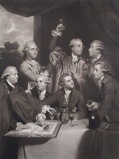
William Say (English engraver, 1768-1834),
after a painting by Sir Joshua Reynolds (English, 1723-1792),
Sir
William Hamilton and Society Dilettante, c. 1780s, mezzotint,
25 1/2 x 18 1/2 inches. See dilettante.

David Lucas (British, 1802-1881), designed
by John Constable (British, 1776-1837), Summer Morning,
c. 1830, mezzotint, proof
before letters, state b,
Metropolitan Museum of Art, NY.

Maurits Cornelis Escher (Dutch, 1898-1972),
Eye, 1946, mezzotint, 7th and final state. See sight.
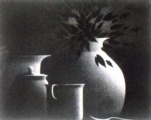
Robert Kipniss (American, 1931-), Still Life with Spoon, 1998, mezzotint, 9 3/8 x 11 5/8 inches, National Academy of Design, NY. See still life.
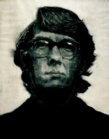
Chuck Close (American, 1940-), Keith,
1972, mezzotint, 114 x 89.5 cm. See Photo-Realism.

Vija Celmins (American, born Latvia, 1939-), Untitled (Web 2), 2001, mezzotint on Hahnemühle Copperplate paper, 18 x 14 3/4 inches, edition of 50, AP of 10, published by Lapis Press, Los Angeles; McKee Gallery, NY.
Related links:
https://inform.quest/_art